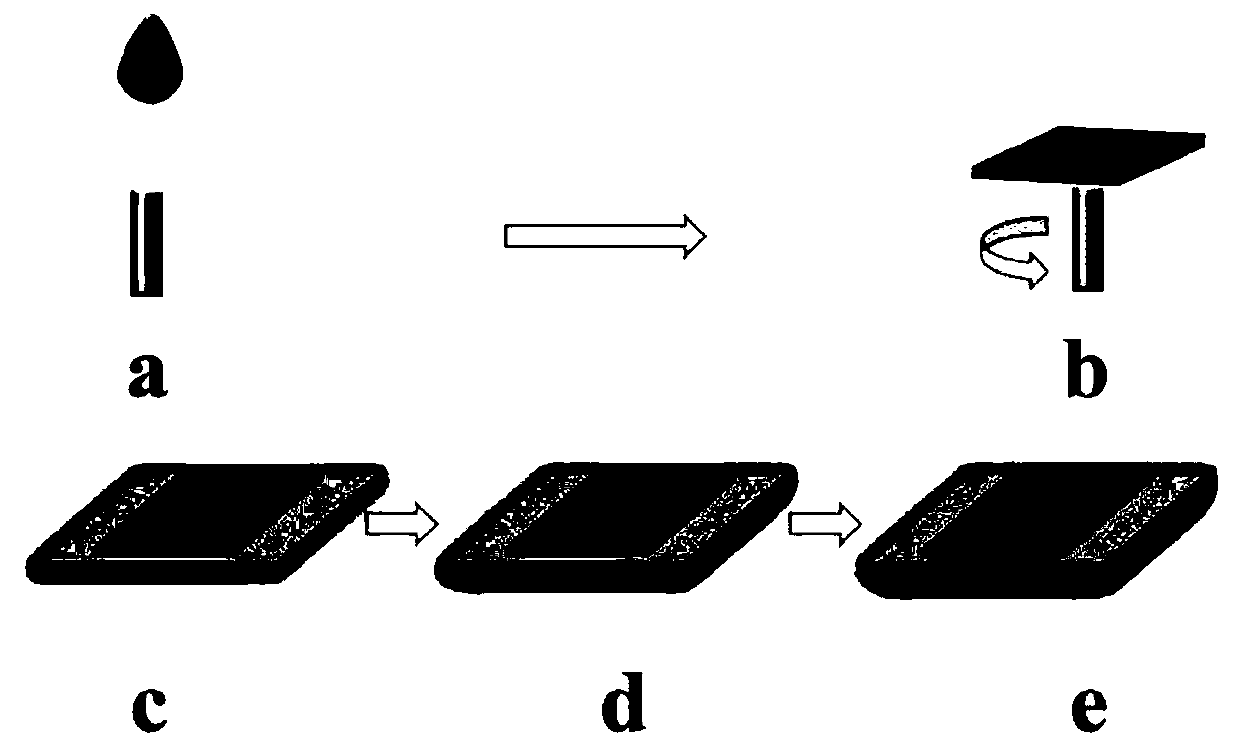Preparation method for efficient CsPbI2Br inorganic perovskite solar cell
A technology for solar cells and inorganic calcium, applied in the field of solar cells, can solve the problems of poor film formation quality, reduce crystal nucleation and crystallization rate, etc., and achieve the effects of quality improvement, porosity reduction, and small human influence factors.
- Summary
- Abstract
- Description
- Claims
- Application Information
AI Technical Summary
Problems solved by technology
Method used
Image
Examples
Embodiment 1
[0022] A highly efficient CsPbI 2 Preparation method of Br inorganic perovskite solar cells, using ITO as conductive substrate, tin dioxide as electron transport layer, CsPbI 2 Br is the light absorbing layer, Spiro-OMeTAD is the hole transport layer, and silver is the counter electrode, such as figure 1 with figure 2 As shown, it specifically includes the following steps:
[0023] Step 1: Put the 2cm×2cm ITO glass into the cleaning rack, clean the surface with deionized water, absolute ethanol, acetone, isopropanol and absolute ethanol in sequence, and dry it with nitrogen gas for later use;
[0024] Step 2: Dilute the tin dioxide colloidal solution with a mass fraction of 20wt.% to 2.67wt.% with deionized water, prepare an appropriate amount of tin dioxide solution, and ultrasonically mix it for 30 minutes to obtain a mixed solution A;
[0025] Step 3: Spin-coat the mixed solution A on the surface of the ITO glass cleaned in step 1, and anneal at 150° C. for 30 minutes t...
Embodiment 2
[0031] A highly efficient CsPbI 2 Preparation method of Br inorganic perovskite solar cells, using FTO as conductive substrate, tin dioxide as electron transport layer, CsPbI 2 Br is the light-absorbing layer, Spiro-OMeTAD is the hole transport layer, and gold is the counter electrode, which specifically includes the following steps:
[0032] Step 1: Put the 2cm×2cm FTO glass into the cleaning rack, clean the surface with deionized water, absolute ethanol, acetone, isopropanol and absolute ethanol in sequence, and dry it with nitrogen gas for later use;
[0033] Step 2: Dilute the tin dioxide colloidal solution with a mass fraction of 20wt.% to 2.67wt.% with deionized water, prepare an appropriate amount of tin dioxide solution, and ultrasonically mix it for 30 minutes to obtain a mixed solution A;
[0034] Step 3: Spin-coat the mixed solution A on the surface of the FTO glass cleaned in step 1, and anneal at 150° C. for 30 minutes to obtain a tin dioxide electron transport l...
Embodiment 3
[0040] A highly efficient CsPbI 2 Preparation method of Br inorganic perovskite solar cells, using ITO as conductive substrate, tin dioxide as electron transport layer, CsPbI 2 Br is the light-absorbing layer, Spiro-OMeTAD is the hole transport layer, and carbon is the counter electrode, which specifically includes the following steps:
[0041] Step 1: Put the 2cm×2cm ITO glass into the cleaning rack, clean the surface with deionized water, absolute ethanol, acetone, isopropanol and absolute ethanol in sequence, and dry it with nitrogen gas for later use;
[0042] Step 2: Dilute the tin dioxide colloidal solution with a mass fraction of 20wt.% to 2.67wt.% with deionized water, prepare an appropriate amount of tin dioxide solution, and ultrasonically mix it for 30 minutes to obtain a mixed solution A;
[0043] Step 3: Spin-coat the mixed solution A on the surface of the ITO glass cleaned in step 1, and anneal at 150° C. for 30 minutes to obtain a tin dioxide electron transport...
PUM
 Login to View More
Login to View More Abstract
Description
Claims
Application Information
 Login to View More
Login to View More - R&D
- Intellectual Property
- Life Sciences
- Materials
- Tech Scout
- Unparalleled Data Quality
- Higher Quality Content
- 60% Fewer Hallucinations
Browse by: Latest US Patents, China's latest patents, Technical Efficacy Thesaurus, Application Domain, Technology Topic, Popular Technical Reports.
© 2025 PatSnap. All rights reserved.Legal|Privacy policy|Modern Slavery Act Transparency Statement|Sitemap|About US| Contact US: help@patsnap.com



